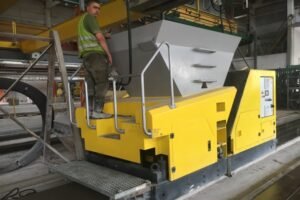Modern construction requires efficient, economical and technologically advanced solutions. Extruder technology for the production of floor slabs, providing high precision, minimizing waste and reducing production costs. As the construction industry continues to evolve, these technologies are improving, opening up new opportunities to increase productivity and product quality.
Advantages of extruder technology
The extruder method of manufacturing reinforced concrete products makes it possible to abandon traditional formwork, which significantly speeds up the production process. Unlike classical methods, in which concrete is poured into molds, the extruder extrudes the concrete mass with precise dosage, creating products with high strength and smooth surface.
Key benefits include:
- Material savings - precise shaping of products reduces concrete mix overspending.
- Production speed - extrusion allows to produce large volumes of products in a short period of time.
- High accuracy - minimal deviations in dimensions simplify the installation process.
- Lack of manual intervention - automated extruders work virtually without human intervention, reducing the risks of defects and errors.
Such advantages make extruder technologies in demand in modern construction, especially in the production of hollow core floor slabs, beams and panels.

Modern innovations in extruder technology
The development of construction technologies leads to improvements in extruder systems. Modern models are equipped with automatic control systems that regulate concrete distribution, extrusion speed and product formation. This allows not only to improve product quality, but also to reduce energy costs.
One of the promising directions is the introduction of robotized complexes that allow changing production parameters in real time. In addition, mobile extruder units capable of working directly on construction sites are being developed, which simplifies logistics and reduces the cost of transportation of finished products.
Another important direction in the development of extruder technologies is the use of high-strength concrete mixtures with additives that increase resistance to loads and unfavorable weather conditions. This makes it possible to produce reinforced concrete products with increased service life and minimal risk of deformation.
Environmental aspects and sustainable development
Modern construction technologies must comply with the principles of sustainable development. Extruder technology helps reduce environmental impact by reducing waste, precisely dosing materials and lowering energy consumption.
Saving cement and other resources makes this method more environmentally friendly, while high molding accuracy avoids scrap processing. In addition, modern extruders can handle recycled building materials, which reduces waste and promotes a closed-loop economy.
An additional benefit is the reduction of carbon dioxide emissions due to lower energy costs. Many companies implementing extruder technology are striving for full automation of production, which also has a positive impact on environmental safety.
Prospects of application of extruder technologies
The demand for reinforced concrete products continues to grow, which stimulates the development of extruder technologies. Hollow core floor slabs are particularly in demand and are actively used in residential, commercial and industrial construction.
In the coming years, we can expect an expanding range of extruded products. In addition to traditional slabs, beams, and panels, more complex architectural elements may be created, allowing architects and designers to utilize more flexible solutions in construction.
In addition, the development of extruder control software will improve production accuracy, reduce resource consumption and minimize the impact of human error.
Extruder technologies are becoming an integral part of modern production of reinforced concrete products. Their development is aimed at increasing productivity, reducing costs and improving environmental performance.
Thanks to automation, the introduction of innovative materials and improved molding accuracy, extruder technology opens up new opportunities for the construction industry. In the future, their proliferation will make it possible to create stronger, more economical and environmentally friendly structures that meet the highest quality standards.


